Travel Through Norway On a Harley-Davidson
By Peter & Kay Forwood
Norway on a Harley (24/7/10 - 3/7/10)
Distance 2079 km (575861 km to 577940 km)

This is part of the sixteenth section of our
around the world trip.
Complete Trip Overview &
Map
Coming from the Finland or read our
previous visit to Norway
24/7/10 Crossed the border into Norway at the same
crossing and on the same day 12 years ago, near Karasjok. Knowing
Norway was going to be expensive we tried to be mentally prepared.
Norway has not joined the EU, preferring to go it alone in Europe.
Despite living on its oil resources petrol is the dearest we have paid
in Europe, about 1.60 Euro a liter, at least at these latitudes. In
increasing cloud and a few sprinkles we rode through to Lakselv, constantly
admiring the more mountainous scenery with its rivers and waterfalls,
and choosing a roadside camp, near the ocean, our first sighting of the
Arctic Ocean, camped for the night while the sun only dimmed slightly.
we rode through to Lakselv, constantly
admiring the more mountainous scenery with its rivers and waterfalls,
and choosing a roadside camp, near the ocean, our first sighting of the
Arctic Ocean, camped for the night while the sun only dimmed slightly.
25/7/10 It was less than 200 km's to Nordkapp, the
furthest north you can ride on a public road in the world. We had been
seeing reindeer in increasing numbers since crossing the Arctic Circle
in Finland but this morning they were everywhere, or at least we could
now see them better as the trees had ceased to grow at these latitudes.
Flighty animals they are easily spooked although quite docile.
Occasionally one will take a dislike to being bitten by mosquitoes and
take off on an extended trot onto the road and across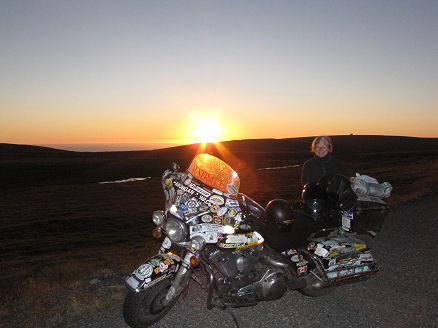 our path. Nordkapp is on an island and since
our last visit, where we had to take a ferry, they have now built a
tunnel, almost 7 km's long, under the ocean. Still charging what seems
to be ferry prices they charge for the vehicle and each passenger,
almost 15 Euro for us. In an extremely rough global warming comparison
we noticed there was less snow lying around this visit compared to our
last one, when the reindeer were sunbaking on the cool white patches.
It was a sunny day, a day of great prospects for a midnight sun
sighting, like twelve years ago, and we stayed awake, heading out from
our campground about 11.30 pm, and there it was, just hanging above the
ocean horizon, doing its ellipse in the sky, at least for the next few
days after which it will start its descend below the horizon each
evening. The price to enter the ever increasingly commercial Nordkapp
enclave has risen to almost 30 Euro each person but it hasn't deterred
most travellers, busloads of whom were parked up there along with
motorhomes and cars. We again chose not to enter, having better things
to do with 60 Euros, and watched the midnight sun hover over the water
from the roadside just short of the top.
our path. Nordkapp is on an island and since
our last visit, where we had to take a ferry, they have now built a
tunnel, almost 7 km's long, under the ocean. Still charging what seems
to be ferry prices they charge for the vehicle and each passenger,
almost 15 Euro for us. In an extremely rough global warming comparison
we noticed there was less snow lying around this visit compared to our
last one, when the reindeer were sunbaking on the cool white patches.
It was a sunny day, a day of great prospects for a midnight sun
sighting, like twelve years ago, and we stayed awake, heading out from
our campground about 11.30 pm, and there it was, just hanging above the
ocean horizon, doing its ellipse in the sky, at least for the next few
days after which it will start its descend below the horizon each
evening. The price to enter the ever increasingly commercial Nordkapp
enclave has risen to almost 30 Euro each person but it hasn't deterred
most travellers, busloads of whom were parked up there along with
motorhomes and cars. We again chose not to enter, having better things
to do with 60 Euros, and watched the midnight sun hover over the water
from the roadside just short of the top.
26/7/10 Nordkapp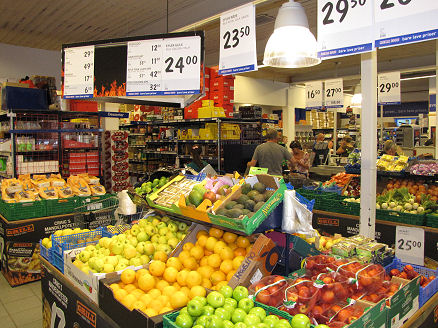 is busier than on our last visit, much
busier. Last night, just after midnight, it was bumper to bumper
traffic leaving the Nordkapp expensively commercial site. More
vehicles, more buses, and many many more motorcycles than on our last
visit. It has almost become a pilgrimage. In contrast to Finland most
of the vehicles here are out of country registered, so despite the
cost, Norway, its scenery and nature, are still drawing tourists. We
are at a comfortable campground in Skarsvag, less than 20 km's from
Nordkapp, over 400 km's above the Arctic Circle, further north than
Prudhoe Bay in Alaska, but the weather is forecast for heavy rain
tomorrow so we decided to hold up here where there is internet and a
comfortable camp kitchen to use it in. Today we rode back to
Honningsvag to shop at the local supermarket, a harrowing experience.
We knew prices were going to be high, but due to the pricing policy at
this supermarket of not placing the prices next to the goods we were
unable to determine what price was for what goods. After half an hour
of trying to compare prices we had five items in our trolley and had
asked staff numerous times "how much is such and such". Hopefully other
supermarkets in the country will function more efficiently, at least
for the consumer.
is busier than on our last visit, much
busier. Last night, just after midnight, it was bumper to bumper
traffic leaving the Nordkapp expensively commercial site. More
vehicles, more buses, and many many more motorcycles than on our last
visit. It has almost become a pilgrimage. In contrast to Finland most
of the vehicles here are out of country registered, so despite the
cost, Norway, its scenery and nature, are still drawing tourists. We
are at a comfortable campground in Skarsvag, less than 20 km's from
Nordkapp, over 400 km's above the Arctic Circle, further north than
Prudhoe Bay in Alaska, but the weather is forecast for heavy rain
tomorrow so we decided to hold up here where there is internet and a
comfortable camp kitchen to use it in. Today we rode back to
Honningsvag to shop at the local supermarket, a harrowing experience.
We knew prices were going to be high, but due to the pricing policy at
this supermarket of not placing the prices next to the goods we were
unable to determine what price was for what goods. After half an hour
of trying to compare prices we had five items in our trolley and had
asked staff numerous times "how much is such and such". Hopefully other
supermarkets in the country will function more efficiently, at least
for the consumer.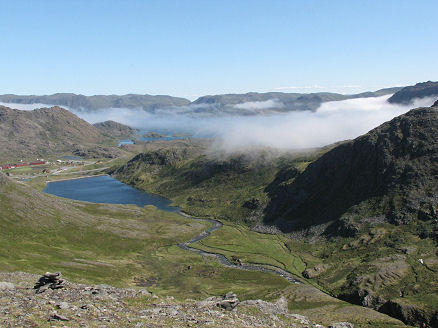 A sea fog rolled in across the hills around
lunch time, clouding the coast and cooling the already cold air. At
first we attempted to ride to the top of nearby hills for sunshine but
gave up late afternoon and settled into the camp kitchen, taking an
evening walk, still in fog, just for a bit of warming up exercise
before dinner.
A sea fog rolled in across the hills around
lunch time, clouding the coast and cooling the already cold air. At
first we attempted to ride to the top of nearby hills for sunshine but
gave up late afternoon and settled into the camp kitchen, taking an
evening walk, still in fog, just for a bit of warming up exercise
before dinner.
27/7/10 Stayed another night. The Skarsvag
campground has all the facilities to keep us there for another night.
Free wireless internet, free hot showers and a warm camp kitchen with
tables and electricity. The day was vastly warmer, perhaps 18 degrees,
but rain was forecast for the late afternoon and heavy overnight, which
it was. We chatted with other travellers, some motorcyclists, a
bicyclist (many of whom make the pilgrimage), Norwegians and
foreigners.
The midnight sun sighting on the 25th was the only one during our stay
but it didn't stop the busloads of tourists, plus the self propelled,
from an attempt.
28/7/10 Still raining in the morning we left late
hoping it would clear, and it almost did, leaving behind a thick fog,
dangerous with reindeer about. The sun never appeared all day and by
the time we were ready to wild camp, alongside the ocean, just near
Badderen, 350 km's down the track, drizzle had set in for the evening
leaving us cold and huddled inside the tent, cooking dinner in bursts
of venturing outside and collecting rainwater in cups from the tent fly
as our supply was almost gone. A small motorhome had also pulled up
near
our campsite, a Finnish couple, a fisherman, who offered us an
irresistible aperitif of freshly cooked fish and a cup of white wine, a
lovely gesture, and sparked up our evening. Most of the scenery of the
day passed us by under fog or low cloud, nothing much was seen, less in
the cold tunnels where the temperature dropped by a few degrees
compared to the outside, as they are dug beneath permafrost.
the ocean, just near
Badderen, 350 km's down the track, drizzle had set in for the evening
leaving us cold and huddled inside the tent, cooking dinner in bursts
of venturing outside and collecting rainwater in cups from the tent fly
as our supply was almost gone. A small motorhome had also pulled up
near
our campsite, a Finnish couple, a fisherman, who offered us an
irresistible aperitif of freshly cooked fish and a cup of white wine, a
lovely gesture, and sparked up our evening. Most of the scenery of the
day passed us by under fog or low cloud, nothing much was seen, less in
the cold tunnels where the temperature dropped by a few degrees
compared to the outside, as they are dug beneath permafrost.
29/7/10 A different day. The rain had stopped
overnight leaving behind rising fog which looked lovely across the
early morning ocean. Also a warmer day and as it progressed the fog
disappeared to leave behind the magnificent views Norway is famous for.
All the waterfalls, and there are dozens, cascading from mountains,
some
from glacier thaw, were all in great strength, white streaks against
the black rock face. The road followed the coast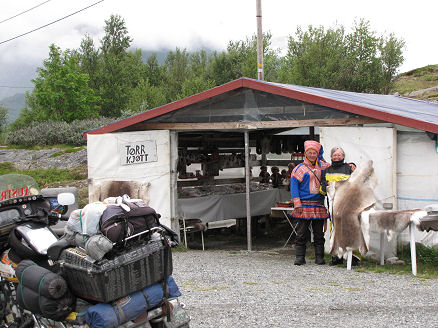 most of the day,
weaving in and out of fjords, finally bringing us to Tromso. Although
it was out of our way, and we had been there just last January, we
wanted to return to see it in summer, and it was vastly different to
the total darkness of winter. In a way it had lost the white fairy lit
appeal yet the streets were now packed with locals and tourists alike,
busying themselves with activity. Further down the road south, and
after 450 km's today, we finally set up camp at a roadside rest area
south of Andselv. Although still above the arctic circle we have left
behind the freedom of the true Norwegian arctic. We are constantly
amazed at how many people live at these latitudes. The reindeer herds
have been replaced by sheep and cattle. Grass is being cut for the next
winters fodder.
There are seasonal fishermen's huts for the salmon run
and large towns, like Tromso, have over 50,000 people, with a
university of
2000 students, all living in a land where in winter the sun doesn't
rise and in summer it doesn't set for long periods. Traffic has
increased on the roads and some of the roadside rest areas now prohibit
overnight parking/camping, something generally allowed in Norway, a
Right of Common
most of the day,
weaving in and out of fjords, finally bringing us to Tromso. Although
it was out of our way, and we had been there just last January, we
wanted to return to see it in summer, and it was vastly different to
the total darkness of winter. In a way it had lost the white fairy lit
appeal yet the streets were now packed with locals and tourists alike,
busying themselves with activity. Further down the road south, and
after 450 km's today, we finally set up camp at a roadside rest area
south of Andselv. Although still above the arctic circle we have left
behind the freedom of the true Norwegian arctic. We are constantly
amazed at how many people live at these latitudes. The reindeer herds
have been replaced by sheep and cattle. Grass is being cut for the next
winters fodder.
There are seasonal fishermen's huts for the salmon run
and large towns, like Tromso, have over 50,000 people, with a
university of
2000 students, all living in a land where in winter the sun doesn't
rise and in summer it doesn't set for long periods. Traffic has
increased on the roads and some of the roadside rest areas now prohibit
overnight parking/camping, something generally allowed in Norway, a
Right of Common Access, that allows
camping for two nights as long as
it is more than 150 metres from the nearest residence. Just two days
ago, tents and motorhomes were overnighting anywhere, dotted along
roadsides, but now most travellers were overnighting in campgrounds. We
have been
told motorhomes are a love hate relationship with the Norwegians. They
come from western and central European locations loaded with food and
fuel, they wild camp, take
fish, and spend little money in Norway to help the economy. But many of
them
do spend money, in restaurants, in campgrounds, helping the economy,
but
not all.
Access, that allows
camping for two nights as long as
it is more than 150 metres from the nearest residence. Just two days
ago, tents and motorhomes were overnighting anywhere, dotted along
roadsides, but now most travellers were overnighting in campgrounds. We
have been
told motorhomes are a love hate relationship with the Norwegians. They
come from western and central European locations loaded with food and
fuel, they wild camp, take
fish, and spend little money in Norway to help the economy. But many of
them
do spend money, in restaurants, in campgrounds, helping the economy,
but
not all.
30/7/10 Just 280 km's to Svolvaer, our planned
destination, where the world's northernmost Harley-Davidson Rally is
underway, the first time one has been held above the Arctic Circle. We
had been seeing many Harleys on the road the last week, travellers
combining a trip to Nordkapp with the rally, and now a few hundred have
concentrated here. Svolvaer is in a beautiful location, in a beautiful
place, the Lofoten Islands. It would have to rate as one of the most
amazing places we have seen for beauty.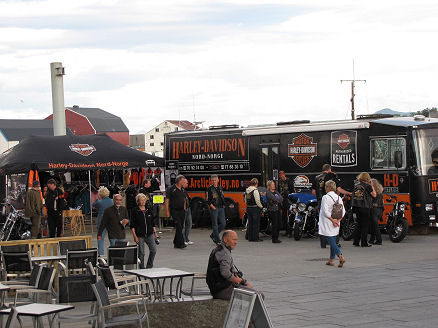 Small colourful
fishing
villages dot the coastline of rocky vegetated islands, and today it was
lovely sunshine for us to enjoy the scenery. Harley's here are
expensive, matching what we believe is the most expensive country in
the world, Norway. An Electraglide Ultra, top of the range H-D sells
for
about 48,000 Euro, about twice the price of the same motorcycle in
Australia. Many of the rally goers are staying in some of the up-market
accommodation available in town, others at cabins in campgrounds, and
us, along with a number of budget conscious riders, are staying in the
rally's free campground at the end of a rough
vegetated island, next to
town. It is a historical spot with WW2 bunkers and a gun emplacement
dotting the headland which is now seasonally used for fish drying where
large weather bleached wooden racks rise from the vegetation. Just
planning a one day visit we didn't register for the rally but spent the
day at the rally grounds, which was open to the public, and in the
evening
listened to the live band, sitting outside the grounds with locals,
mostly migrant refugees, who were as yet unable to afford or unwilling
to pay the entrance cost to the concert.
Small colourful
fishing
villages dot the coastline of rocky vegetated islands, and today it was
lovely sunshine for us to enjoy the scenery. Harley's here are
expensive, matching what we believe is the most expensive country in
the world, Norway. An Electraglide Ultra, top of the range H-D sells
for
about 48,000 Euro, about twice the price of the same motorcycle in
Australia. Many of the rally goers are staying in some of the up-market
accommodation available in town, others at cabins in campgrounds, and
us, along with a number of budget conscious riders, are staying in the
rally's free campground at the end of a rough
vegetated island, next to
town. It is a historical spot with WW2 bunkers and a gun emplacement
dotting the headland which is now seasonally used for fish drying where
large weather bleached wooden racks rise from the vegetation. Just
planning a one day visit we didn't register for the rally but spent the
day at the rally grounds, which was open to the public, and in the
evening
listened to the live band, sitting outside the grounds with locals,
mostly migrant refugees, who were as yet unable to afford or unwilling
to pay the entrance cost to the concert.
31/7/10 One day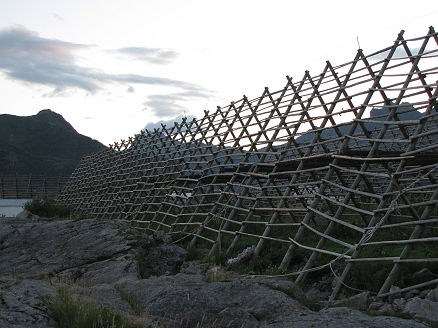 sunshine, one day rain, probably
better odds than Norway has been getting weather wise this summer. This
morning we awoke to rain and after hot muesli and tea, cooked in part
of a WW2 bunker, out of the rain, we headed to town where a local
coffee
shop offered free wi/fi, for the price of a coffee, and where we stayed
for a couple of hours. It was still raining when we left, bumping into
Marcus Kingma, who is riding from the Netherlands to Nordkapp in aid of
MDA the charity that Harley worldwide sponsors. He is doing daily
updates to the internet along the route and interviewed
us, in the rain, as part of todays update, and it was posted on
"YouTube" this evening, a first for us. The rain brought cold
weather
and most rally goers chose to spend the day in their hotel rooms or at
a restaurant/bar with only a few out and about at the rally grounds. As
an aside we noticed whale meat on sale in local restaurants in
town and from a vendor in H-D rally grounds. By evening we'd had enough
of the weather and were early to our tent though the locals continued
to party, despite a pub beer costing over 6 Euro, and the local
supermarkets, who are only allowed to sell soft alcohol (no wine or
spirits), having to close their liquor sales at 3 pm this afternoon. It
surprises
sunshine, one day rain, probably
better odds than Norway has been getting weather wise this summer. This
morning we awoke to rain and after hot muesli and tea, cooked in part
of a WW2 bunker, out of the rain, we headed to town where a local
coffee
shop offered free wi/fi, for the price of a coffee, and where we stayed
for a couple of hours. It was still raining when we left, bumping into
Marcus Kingma, who is riding from the Netherlands to Nordkapp in aid of
MDA the charity that Harley worldwide sponsors. He is doing daily
updates to the internet along the route and interviewed
us, in the rain, as part of todays update, and it was posted on
"YouTube" this evening, a first for us. The rain brought cold
weather
and most rally goers chose to spend the day in their hotel rooms or at
a restaurant/bar with only a few out and about at the rally grounds. As
an aside we noticed whale meat on sale in local restaurants in
town and from a vendor in H-D rally grounds. By evening we'd had enough
of the weather and were early to our tent though the locals continued
to party, despite a pub beer costing over 6 Euro, and the local
supermarkets, who are only allowed to sell soft alcohol (no wine or
spirits), having to close their liquor sales at 3 pm this afternoon. It
surprises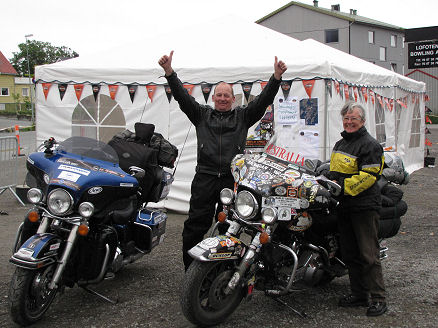 us that anyone could get drunk in this
country at all, yet
there were a couple of alcoholics/drunks at the end of the town pier,
and one outside the supermarket who we encountered yesterday,
indicating that, as the US found in the prohibition years, and the
Saudi Government understands, people will find ways to get alcohol
despite the cost and government regulations.
us that anyone could get drunk in this
country at all, yet
there were a couple of alcoholics/drunks at the end of the town pier,
and one outside the supermarket who we encountered yesterday,
indicating that, as the US found in the prohibition years, and the
Saudi Government understands, people will find ways to get alcohol
despite the cost and government regulations.
1/8/10 Over 100 of the more than a thousand
estimated participants at the rally booked on the extension, a ride to
Nordkapp, three days, leaving midday. Marcus was riding with them for
the first day to obtain some camera footage and then would be on his
own agenda, for MDA, for the last push to the top. The punters were
milling
around the registration area when Marcus asked if I could interview
Kula, the Director of the Arctic Chapter, the rally organisers, as my
English was better than his Dutch accented version. My first ever
interview, on the questions asking side rather than the answering, is
also on You Tube. Most of the other rally goers also left, heading
home, or extending their visit to tour the islands. We headed south, in
increasing sunshine, towards the town of Å, pronounced Aw, at the
bottom of the Lofoten Islands, leaving behind the fog cloud that was
hiding sunshine in Svolvaer. If it is possible the scenery improved the
further south we went till it reached a pinnacle at Sakrisoy, a small
fishing village, backdropped by sheer mountain cliffs sliding into a
mirror bay. We turned around at Å and headed north late evening taking
a roadside camp, in full sunshine, drying our humidity damp sleeping
bags on the rocks, and watched the sun move horizontally across the
sky, setting slowly.
of Å, pronounced Aw, at the
bottom of the Lofoten Islands, leaving behind the fog cloud that was
hiding sunshine in Svolvaer. If it is possible the scenery improved the
further south we went till it reached a pinnacle at Sakrisoy, a small
fishing village, backdropped by sheer mountain cliffs sliding into a
mirror bay. We turned around at Å and headed north late evening taking
a roadside camp, in full sunshine, drying our humidity damp sleeping
bags on the rocks, and watched the sun move horizontally across the
sky, setting slowly.
2/8/10 A foggy morning. The days here have started
badly and generally improved but today it drizzle rained till early
afternoon moving us quickly northwards till after lunch we were back in
Svolvaer, where at the end of the pier you can take a shower and do
laundry, and here we sat, inside and warm, venturing out only for wi/fi
and groceries, till we, and everything we own, was washed and dry. It
was 10 pm when we left Svolvaer to look for a roadside camp spot,
totally clean, and again wild camped alongside a lake.
alongside a lake.
3/8/10 More drizzle and a strong cold head wind as
we headed north out of the Lofotens stopping once for a warming hot
chocolate and again for a comfortable chair in the tourist centre in
Narvik. By late afternoon we were heading for Sweden, across the E10,
rising into the low cloud that had been hanging over us for the day.
Here, above the tree line, Norwegians have built small cabins, holiday
cabins, amongst the lakes, dotting them on the rocky outcrops in lovely
settings.
Move with us to Sweden or go to our next visit to Norway
 we rode through to Lakselv, constantly
admiring the more mountainous scenery with its rivers and waterfalls,
and choosing a roadside camp, near the ocean, our first sighting of the
Arctic Ocean, camped for the night while the sun only dimmed slightly.
we rode through to Lakselv, constantly
admiring the more mountainous scenery with its rivers and waterfalls,
and choosing a roadside camp, near the ocean, our first sighting of the
Arctic Ocean, camped for the night while the sun only dimmed slightly. 
 our path. Nordkapp is on an island and since
our last visit, where we had to take a ferry, they have now built a
tunnel, almost 7 km's long, under the ocean. Still charging what seems
to be ferry prices they charge for the vehicle and each passenger,
almost 15 Euro for us. In an extremely rough global warming comparison
we noticed there was less snow lying around this visit compared to our
last one, when the reindeer were sunbaking on the cool white patches.
It was a sunny day, a day of great prospects for a midnight sun
sighting, like twelve years ago, and we stayed awake, heading out from
our campground about 11.30 pm, and there it was, just hanging above the
ocean horizon, doing its ellipse in the sky, at least for the next few
days after which it will start its descend below the horizon each
evening. The price to enter the ever increasingly commercial Nordkapp
enclave has risen to almost 30 Euro each person but it hasn't deterred
most travellers, busloads of whom were parked up there along with
motorhomes and cars. We again chose not to enter, having better things
to do with 60 Euros, and watched the midnight sun hover over the water
from the roadside just short of the top.
our path. Nordkapp is on an island and since
our last visit, where we had to take a ferry, they have now built a
tunnel, almost 7 km's long, under the ocean. Still charging what seems
to be ferry prices they charge for the vehicle and each passenger,
almost 15 Euro for us. In an extremely rough global warming comparison
we noticed there was less snow lying around this visit compared to our
last one, when the reindeer were sunbaking on the cool white patches.
It was a sunny day, a day of great prospects for a midnight sun
sighting, like twelve years ago, and we stayed awake, heading out from
our campground about 11.30 pm, and there it was, just hanging above the
ocean horizon, doing its ellipse in the sky, at least for the next few
days after which it will start its descend below the horizon each
evening. The price to enter the ever increasingly commercial Nordkapp
enclave has risen to almost 30 Euro each person but it hasn't deterred
most travellers, busloads of whom were parked up there along with
motorhomes and cars. We again chose not to enter, having better things
to do with 60 Euros, and watched the midnight sun hover over the water
from the roadside just short of the top.  is busier than on our last visit, much
busier. Last night, just after midnight, it was bumper to bumper
traffic leaving the Nordkapp expensively commercial site. More
vehicles, more buses, and many many more motorcycles than on our last
visit. It has almost become a pilgrimage. In contrast to Finland most
of the vehicles here are out of country registered, so despite the
cost, Norway, its scenery and nature, are still drawing tourists. We
are at a comfortable campground in Skarsvag, less than 20 km's from
Nordkapp, over 400 km's above the Arctic Circle, further north than
Prudhoe Bay in Alaska, but the weather is forecast for heavy rain
tomorrow so we decided to hold up here where there is internet and a
comfortable camp kitchen to use it in. Today we rode back to
Honningsvag to shop at the local supermarket, a harrowing experience.
We knew prices were going to be high, but due to the pricing policy at
this supermarket of not placing the prices next to the goods we were
unable to determine what price was for what goods. After half an hour
of trying to compare prices we had five items in our trolley and had
asked staff numerous times "how much is such and such". Hopefully other
supermarkets in the country will function more efficiently, at least
for the consumer.
is busier than on our last visit, much
busier. Last night, just after midnight, it was bumper to bumper
traffic leaving the Nordkapp expensively commercial site. More
vehicles, more buses, and many many more motorcycles than on our last
visit. It has almost become a pilgrimage. In contrast to Finland most
of the vehicles here are out of country registered, so despite the
cost, Norway, its scenery and nature, are still drawing tourists. We
are at a comfortable campground in Skarsvag, less than 20 km's from
Nordkapp, over 400 km's above the Arctic Circle, further north than
Prudhoe Bay in Alaska, but the weather is forecast for heavy rain
tomorrow so we decided to hold up here where there is internet and a
comfortable camp kitchen to use it in. Today we rode back to
Honningsvag to shop at the local supermarket, a harrowing experience.
We knew prices were going to be high, but due to the pricing policy at
this supermarket of not placing the prices next to the goods we were
unable to determine what price was for what goods. After half an hour
of trying to compare prices we had five items in our trolley and had
asked staff numerous times "how much is such and such". Hopefully other
supermarkets in the country will function more efficiently, at least
for the consumer. A sea fog rolled in across the hills around
lunch time, clouding the coast and cooling the already cold air. At
first we attempted to ride to the top of nearby hills for sunshine but
gave up late afternoon and settled into the camp kitchen, taking an
evening walk, still in fog, just for a bit of warming up exercise
before dinner.
A sea fog rolled in across the hills around
lunch time, clouding the coast and cooling the already cold air. At
first we attempted to ride to the top of nearby hills for sunshine but
gave up late afternoon and settled into the camp kitchen, taking an
evening walk, still in fog, just for a bit of warming up exercise
before dinner.  the ocean, just near
Badderen, 350 km's down the track, drizzle had set in for the evening
leaving us cold and huddled inside the tent, cooking dinner in bursts
of venturing outside and collecting rainwater in cups from the tent fly
as our supply was almost gone. A small motorhome had also pulled up
near
our campsite, a Finnish couple, a fisherman, who offered us an
irresistible aperitif of freshly cooked fish and a cup of white wine, a
lovely gesture, and sparked up our evening. Most of the scenery of the
day passed us by under fog or low cloud, nothing much was seen, less in
the cold tunnels where the temperature dropped by a few degrees
compared to the outside, as they are dug beneath permafrost.
the ocean, just near
Badderen, 350 km's down the track, drizzle had set in for the evening
leaving us cold and huddled inside the tent, cooking dinner in bursts
of venturing outside and collecting rainwater in cups from the tent fly
as our supply was almost gone. A small motorhome had also pulled up
near
our campsite, a Finnish couple, a fisherman, who offered us an
irresistible aperitif of freshly cooked fish and a cup of white wine, a
lovely gesture, and sparked up our evening. Most of the scenery of the
day passed us by under fog or low cloud, nothing much was seen, less in
the cold tunnels where the temperature dropped by a few degrees
compared to the outside, as they are dug beneath permafrost.  most of the day,
weaving in and out of fjords, finally bringing us to Tromso. Although
it was out of our way, and we had been there just last January, we
wanted to return to see it in summer, and it was vastly different to
the total darkness of winter. In a way it had lost the white fairy lit
appeal yet the streets were now packed with locals and tourists alike,
busying themselves with activity. Further down the road south, and
after 450 km's today, we finally set up camp at a roadside rest area
south of Andselv. Although still above the arctic circle we have left
behind the freedom of the true Norwegian arctic. We are constantly
amazed at how many people live at these latitudes. The reindeer herds
have been replaced by sheep and cattle. Grass is being cut for the next
winters fodder.
There are seasonal fishermen's huts for the salmon run
and large towns, like Tromso, have over 50,000 people, with a
university of
2000 students, all living in a land where in winter the sun doesn't
rise and in summer it doesn't set for long periods. Traffic has
increased on the roads and some of the roadside rest areas now prohibit
overnight parking/camping, something generally allowed in Norway, a
Right of Common
most of the day,
weaving in and out of fjords, finally bringing us to Tromso. Although
it was out of our way, and we had been there just last January, we
wanted to return to see it in summer, and it was vastly different to
the total darkness of winter. In a way it had lost the white fairy lit
appeal yet the streets were now packed with locals and tourists alike,
busying themselves with activity. Further down the road south, and
after 450 km's today, we finally set up camp at a roadside rest area
south of Andselv. Although still above the arctic circle we have left
behind the freedom of the true Norwegian arctic. We are constantly
amazed at how many people live at these latitudes. The reindeer herds
have been replaced by sheep and cattle. Grass is being cut for the next
winters fodder.
There are seasonal fishermen's huts for the salmon run
and large towns, like Tromso, have over 50,000 people, with a
university of
2000 students, all living in a land where in winter the sun doesn't
rise and in summer it doesn't set for long periods. Traffic has
increased on the roads and some of the roadside rest areas now prohibit
overnight parking/camping, something generally allowed in Norway, a
Right of Common Access, that allows
camping for two nights as long as
it is more than 150 metres from the nearest residence. Just two days
ago, tents and motorhomes were overnighting anywhere, dotted along
roadsides, but now most travellers were overnighting in campgrounds. We
have been
told motorhomes are a love hate relationship with the Norwegians. They
come from western and central European locations loaded with food and
fuel, they wild camp, take
fish, and spend little money in Norway to help the economy. But many of
them
do spend money, in restaurants, in campgrounds, helping the economy,
but
not all.
Access, that allows
camping for two nights as long as
it is more than 150 metres from the nearest residence. Just two days
ago, tents and motorhomes were overnighting anywhere, dotted along
roadsides, but now most travellers were overnighting in campgrounds. We
have been
told motorhomes are a love hate relationship with the Norwegians. They
come from western and central European locations loaded with food and
fuel, they wild camp, take
fish, and spend little money in Norway to help the economy. But many of
them
do spend money, in restaurants, in campgrounds, helping the economy,
but
not all.  Small colourful
fishing
villages dot the coastline of rocky vegetated islands, and today it was
lovely sunshine for us to enjoy the scenery. Harley's here are
expensive, matching what we believe is the most expensive country in
the world, Norway. An Electraglide Ultra, top of the range H-D sells
for
about 48,000 Euro, about twice the price of the same motorcycle in
Australia. Many of the rally goers are staying in some of the up-market
accommodation available in town, others at cabins in campgrounds, and
us, along with a number of budget conscious riders, are staying in the
rally's free campground at the end of a rough
vegetated island, next to
town. It is a historical spot with WW2 bunkers and a gun emplacement
dotting the headland which is now seasonally used for fish drying where
large weather bleached wooden racks rise from the vegetation. Just
planning a one day visit we didn't register for the rally but spent the
day at the rally grounds, which was open to the public, and in the
evening
listened to the live band, sitting outside the grounds with locals,
mostly migrant refugees, who were as yet unable to afford or unwilling
to pay the entrance cost to the concert.
Small colourful
fishing
villages dot the coastline of rocky vegetated islands, and today it was
lovely sunshine for us to enjoy the scenery. Harley's here are
expensive, matching what we believe is the most expensive country in
the world, Norway. An Electraglide Ultra, top of the range H-D sells
for
about 48,000 Euro, about twice the price of the same motorcycle in
Australia. Many of the rally goers are staying in some of the up-market
accommodation available in town, others at cabins in campgrounds, and
us, along with a number of budget conscious riders, are staying in the
rally's free campground at the end of a rough
vegetated island, next to
town. It is a historical spot with WW2 bunkers and a gun emplacement
dotting the headland which is now seasonally used for fish drying where
large weather bleached wooden racks rise from the vegetation. Just
planning a one day visit we didn't register for the rally but spent the
day at the rally grounds, which was open to the public, and in the
evening
listened to the live band, sitting outside the grounds with locals,
mostly migrant refugees, who were as yet unable to afford or unwilling
to pay the entrance cost to the concert.  sunshine, one day rain, probably
better odds than Norway has been getting weather wise this summer. This
morning we awoke to rain and after hot muesli and tea, cooked in part
of a WW2 bunker, out of the rain, we headed to town where a local
coffee
shop offered free wi/fi, for the price of a coffee, and where we stayed
for a couple of hours. It was still raining when we left, bumping into
Marcus Kingma, who is riding from the Netherlands to Nordkapp in aid of
MDA the charity that Harley worldwide sponsors. He is doing daily
updates to the internet along the route and
sunshine, one day rain, probably
better odds than Norway has been getting weather wise this summer. This
morning we awoke to rain and after hot muesli and tea, cooked in part
of a WW2 bunker, out of the rain, we headed to town where a local
coffee
shop offered free wi/fi, for the price of a coffee, and where we stayed
for a couple of hours. It was still raining when we left, bumping into
Marcus Kingma, who is riding from the Netherlands to Nordkapp in aid of
MDA the charity that Harley worldwide sponsors. He is doing daily
updates to the internet along the route and  us that anyone could get drunk in this
country at all, yet
there were a couple of alcoholics/drunks at the end of the town pier,
and one outside the supermarket who we encountered yesterday,
indicating that, as the US found in the prohibition years, and the
Saudi Government understands, people will find ways to get alcohol
despite the cost and government regulations.
us that anyone could get drunk in this
country at all, yet
there were a couple of alcoholics/drunks at the end of the town pier,
and one outside the supermarket who we encountered yesterday,
indicating that, as the US found in the prohibition years, and the
Saudi Government understands, people will find ways to get alcohol
despite the cost and government regulations.  of Å, pronounced Aw, at the
bottom of the Lofoten Islands, leaving behind the fog cloud that was
hiding sunshine in Svolvaer. If it is possible the scenery improved the
further south we went till it reached a pinnacle at Sakrisoy, a small
fishing village, backdropped by sheer mountain cliffs sliding into a
mirror bay. We turned around at Å and headed north late evening taking
a roadside camp, in full sunshine, drying our humidity damp sleeping
bags on the rocks, and watched the sun move horizontally across the
sky, setting slowly.
of Å, pronounced Aw, at the
bottom of the Lofoten Islands, leaving behind the fog cloud that was
hiding sunshine in Svolvaer. If it is possible the scenery improved the
further south we went till it reached a pinnacle at Sakrisoy, a small
fishing village, backdropped by sheer mountain cliffs sliding into a
mirror bay. We turned around at Å and headed north late evening taking
a roadside camp, in full sunshine, drying our humidity damp sleeping
bags on the rocks, and watched the sun move horizontally across the
sky, setting slowly.  alongside a lake.
alongside a lake.